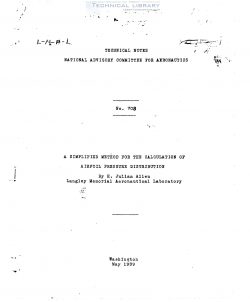naca-tn-708
- Version
- 56 Downloads
- 798.00 KB File Size
- 1 File Count
- November 29, 2016 Create Date
- November 29, 2016 Last Updated
National Advisory Committee for Aeronautics, Technical Notes - A Simplified Method for the Calculation of Airfoil Pressure Distribution

A method is presented for the rapid calculation of
the pressure distribution over an airfoil section when
the normal—force distribution and the pressure distribu~
tion over the "base profile" (i.e., the profile of the
same airfoil were the camber line straight and the re~
sulting airfoil at zero angle of attack) are known, This
note is intended as a supplement to N.A.C.A. Reports Nos.
631 and 634 wherein methods are presented for the calcu-
lation of the normal—force distribution over plain and
flapped airfoils, respectively, but not of the pressures
on the individual surfaces.
Baseaprofile pressure—coefficient distributions for
the usual N.A.0.A. family of airfoils, which are also
suitable for several other commonly employed airfoils, are
included in tabular form. With these tabulated base—
profile pressures and the computed normalwforce distribu~
tions, pressure distributions adequate for most engineer—
ing purposes can be obtained.
A method is given in reference 1 for camputing the
chordwise pressure distribution over both the upper and
-the lower surfaces of an airfoil. In this method, a per-
fect nonviscous fluid was assumed and, consequently, the
agreement between the integrated forces and moments and
those obtained from experimental observations was in_many
cases inadequate. In the work reported in reference 2,
the effect of viscosity was accounted for by an adjustment
of the mean camber line of the airfoil and the agreement
was improved. Both methods, however, are too laborious
for practical use even though the results might be consid~
ered adequate for design purposes.
A subsequent analysis of theory and experimental data
(references 3 and 4) resulted in a series of charts where-
by the normal-force distributions, but not the pressures
on the individual surfaces, could be obtained for ordinary
airfoils and airfoils with flaps. In this method, the
magnitudes of the various component distributions that are
added to obtain the normal—force distribution are deter—
mined from experimental force and moment coefficients.
When the calculated normal—force distribution is inte—
grated, it then yields normal-force and moment coeffi-
cients that must agree in magnitude with the corresponding
experimental coefficients.
| File | Action |
|---|---|
| naca-tn-708 A Simplified Method for the Calculation of Airfoil Pressure Distribution.pdf | Download |
Comment On This Post